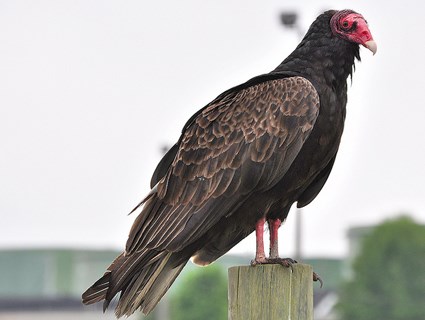
Cathartes aura
SUBFAMILY
Catharnae
TAXONOMY
Vultur aura Linnaeus, 1758, Veracruz, Mexico. Four supspecies.
OTHER COMMON NAMES
French: Urubu а tкte rouge; German: Truthahngeier; Spanish:
Aura Gallipavo.
PHYSICAL CHARACTERISTICS
Depending on race 1.9–4.4 lb (0.85–2 kg); 25.2–31.9 in (64–81
cm); sexually monomorphic. Brownish black plumage with bare
head and neck; skin color varies from pink to bright red.
DISTRIBUTION
Southern border of Canada in North America to Tierra del
Fuego, Chile, winter migration from northern portions of
United States to Central America and north and central South
America. Has been expanding its range north over the last
three decades.
HABITAT
Woodland, savanna, desert, and seashore.
BEHAVIOR
Roosts socially and hunts for carrion in small groups or singly
using olfaction. Lowest status at large carcasses generally subordinate
to larger vultures. When caught will regurgitate and
feign death.
FEEDING ECOLOGY AND DIET
Will feed on dead animals of any size but specializes on
smaller carcasses found by relying on olfaction. Has been seen
to feed on rotten fruit and vegetables.
REPRODUCTIVE BIOLOGY
Two eggs are brown blotched over a cream base; nests in shallow
cave, on the ground in dense vegetation, or in hollow log;
38–41 days of incubation. Both parents tend eggs and young.
Chick “down” color white gradually changing overall to dark
brown as contour feathers emerge. Fledging from nest area at
about 67 days with a relatively short parental dependency period
of a few weeks.
CONSERVATION STATUS
Not threatened. Populations seem stable in most areas unless
roost trees are destroyed. Expanded use of road kills and laws
against shooting large birds are possible reasons for recent
northward expansion.
SIGNIFICANCE TO HUMANS
Never used as food.
Other popular Animals
Photo Gallery of - Turkey vulture




 Animalia Life
Animalia Life